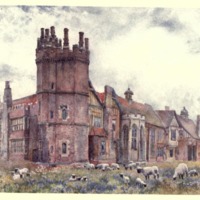Description
Connecting the Mayflower to popular history and literature, Marcus Huish, writing in 1907, provides an extract from George Elliot’s Mill on the Floss and a brief narrative of events relating to The Old Hall, Gainsborough:
"'All down the middle ages events of importance occurred at Gainsborough, and it must throughout that time have always possessed a castle or principal mansion. One such still exists and has a quite respectable antiquity'. George Eliot thus describes it in her Mill on the Floss the scene of which is laid at Gainsborough, which she calls St. Oggs.
'It was the Normans who began to build that fine old hall, which is like the town, telling of the thoughts and hands of widely sundered generations; but it is all so old that we look with loving pardon at its inconsistencies, and are well content that they who built the stone oriel, and they who built the Gothic facade and towers of finest small brickwork with the trefoil ornament, did not sacrilegiously pull down the ancient half-timbered body with its oak-roofed banqueting hall.'
The Norman part referred to by the novelist was probably erected in the reign of Stephen, the oriel by Richard de Gaynesburgh, a distinguished mason who was employed in beautifying the cathedral at Lincoln at the end of the fourteenth century, and who is buried in that building. Part of it was built about the time that the events narrated in this volume took place, by a member of the Hickman family, in whose possession it still remains, its present owner being Sir Hickman Bacon, premier Baronet of England. It has always been a tradition that the Separatists were allowed to meet in this hall by consent of the then owner. Sir William Hickman, whose family were Puritans. Against this, however, must be set the fact that Sir William was knighted by James I. in 1603, and it would be highly improbable that he would imperil his status at Court by giving shelter to abjurants of royal authority. In 1896 times had changed, and by per- mission of his descendant. Sir Hickman Bacon, the banquet on the opening of the Memorial Church was held in the very room in which the worshippers of three centuries ago had met in secret."

